Text
Breaking Barriers: The Rise of Women in Athletic Training

The field of athletic training has seen a surge in women entering the profession since the 1970s. Here at the University of Idaho, we've seen many women embark on their journeys as athletic trainers. Let's explore some common questions they have:
What is an athletic trainer?
Athletic trainers are healthcare professionals who work with active individuals in various settings. They provide services like injury prevention, rehabilitation, and clinical care.
How to become an athletic trainer:
To become certified, you need a master's degree from an accredited program and pass a national exam.
Famous female athletic trainers:
Gail Weldon: One of the first female members of the National Athletic Trainers' Association (NATA) and the first woman inducted into their Hall of Fame.
Sue Falsone: The first female head athletic trainer in a major American professional sports league (LA Dodgers).
Challenges for women:
While the field is evolving, some outdated views persist. Some may question if women can work effectively with male athletes or hold unconscious biases about their competence.
Women in professional sports:
Female athletic trainers are under-represented in male professional sports, but they are increasingly present in secondary schools and collegiate athletics. This exposure helps break down stigmas and demonstrates their capabilities.
Income gap:
A salary gap exists, with women earning an average of $8,700 less per year than men. This can be partially explained by more women being young professionals with fewer supervisory roles. However, it also raises questions about career trajectory and needs further exploration.
The future for women:
Despite challenges, this is an exciting time! Women are entering diverse practice settings and breaking down barriers. The University of Idaho is committed to supporting women in athletic training, fostering a more inclusive and equitable future for the profession.
#athletictraining#womeninathletictraining#womeninscience#healthcare#careergoals#breakingbarriers#diversityinequityinclusion#universityofidaho#athletictrainingprofessionals
0 notes
Text
6 Effective Steps to Improving Communication in Athletic Training

Being an athletic trainer isn't just about treating injuries. Strong communication is key, especially when delivering bad news to athletes or patients. This blog post dives into the SPIKES mnemonic, a tool developed to help healthcare professionals have difficult conversations effectively.
Why is communication important for athletic trainers?
Athletic trainers build long-term relationships with patients, making clear communication crucial. They often need to have difficult conversations, like delivering bad news about an injury or recovery timeline.
What is SPIKES and how can you use it?
SPIKES stands for:
Setting: Choose a private, distraction-free environment where you can sit down and talk one-on-one (unless the patient prefers otherwise).
Perception: Understand the patient's current understanding of their situation. Ask questions to see what they already know.
Invitation: Gauge the patient's willingness to hear more. Ask if they want to discuss the details and how much information they need.
Knowledge: Deliver the news clearly and concisely. Be honest and avoid sugarcoating, but also be mindful of their emotional state. Allow time for them to process the information.
Empathy: Acknowledge their feelings and offer support. Validate their emotions and let them know it's okay to feel upset or frustrated.
Summary: Briefly summarize the key points and create a "game plan" together. This includes follow-up appointments, contact information, and what to do if they experience further issues.
By mastering the SPIKES method, you can ensure that even challenging conversations are handled with compassion and clarity, ultimately strengthening your relationships with your patients.
#universityofidaho#communicationstrategies#spikemnemonic#deliveringbadnews#patientcare#patientrelationships#athletictrainerskills#mentalhealth#emotionalwellbeing#athletesupport
0 notes
Text
The Pros & Cons of Social Media for Athletic Trainers

Social media is everywhere, and while it can be distracting, it also offers valuable tools for athletic trainers (ATs). Here's a breakdown of how athletic trainers can use social media effectively, the potential downsides, and some key guidelines to follow:
How Can Athletic Trainers Use Social Media?
Promote their organization: Increase visibility and attract new patients.
Provide patient care: Use secure platforms for monitoring health, encouraging healthy habits, and facilitating communication.
Educate patients: Share reliable information through blogs, videos, and online communities.
Why is Social Media Valuable for Athletic Trainers?
Patients are already using social media to connect with healthcare providers, learn about services, and interact with others.
Athletic trainers can leverage these platforms to connect with patients, promote their services, and improve patient outcomes.
What are the Downsides of Social Media?
Unprofessional content: Posting inappropriate content can damage your professional image.
Boundary violations: Connecting with patients on social media can compromise professional boundaries.
Legal and licensing issues: Inappropriate use can lead to disciplinary actions and legal issues. HIPAA regulations require protecting patient privacy online.
How to Use Social Media Professionally:
Share credible information only.
Be mindful of legal concerns (privacy, copyright).
Follow your state's licensing requirements.
Don't contact patients to connect on personal networks.
Avoid giving specific medical advice online.
Protect patient privacy with strong security settings and obtain consent when necessary.
Maintain separate personal and professional profiles.
Disclose any financial or in-kind compensation received.
Social media can be a powerful tool for athletic trainers, but it's important to use it ethically and responsibly. By following these guidelines, athletic trainers can leverage the benefits of social media while avoiding potential pitfalls.
#athletictraining#healthcare#socialmedia#healthcareprofessional#socialmediabenefits#socialmediarisk#socialmediaguidelines#patientprivacy#legalissues#licensing#universityofidaho
0 notes
Text
Checklist for Becoming an Athletic Trainer
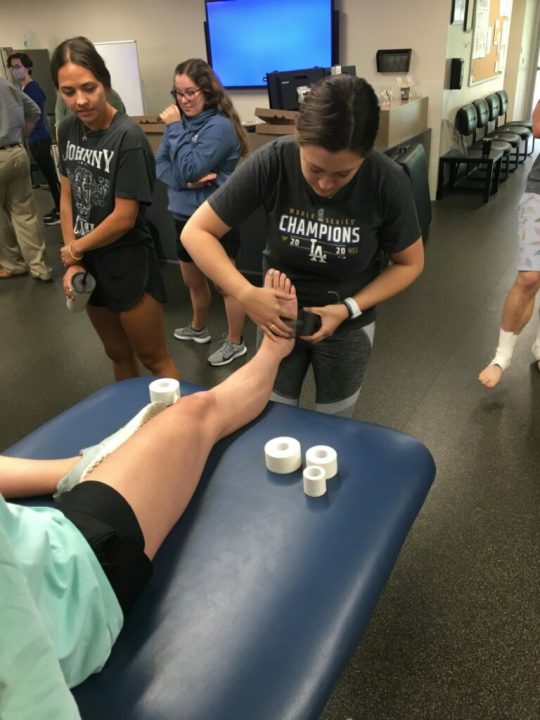
So You Want to be an Athletic Trainer?
Athletic training is a booming field that combines your passion for active lifestyles with healthcare expertise.
What do they do?
Athletic trainers are like versatile healthcare providers who help people in many ways:
Emergency care: They're there on the field during competitions, ready to act fast.
Diagnosis and rehab: They help patients recover from injuries and get back to their activities.
Prevention: They work to prevent injuries from happening in the first place.
Where do they work?
The variety is amazing! You could find yourself:
Working with college or professional sports teams (the classic image!).
Helping athletes in high schools, public safety settings, or even factories.
Supporting dancers, actors, or even theme park performers!
What skills do they need?
Communication: They need to listen carefully and explain things clearly, even in noisy environments.
Technical knowledge: They need to understand the human body and how to assess injuries.
Stress tolerance: They can make quick decisions under pressure and handle difficult situations.
Empathy and compassion: They care about their patients and want to help them through tough times.
Do you have what it takes?
This article explores the key skills and knowledge needed to be a successful athletic trainer. If you see yourself in this description and are eager to learn and grow, then this career path might be perfect for you!
#healthcare#careerdevelopment#healthcarecareers#activelifestyle#sportsmedicine#injuryprevention#wellness#communication#technicalskills#athletictraining#universityofidaho#athletictrainingprofessionals#athleticcareer
0 notes
Text
5 Questions That Will Make You Shine in Your Athletic Training Interview

This passage provides guidance for aspiring athletic trainers preparing for job interviews. While technical questions are expected, specific examples highlight several crucial topics interviewers may explore:
1. Defining Success in Patient Interactions:
This question reveals your values and what you prioritize when interacting with patients.
Reflect on past interactions and what made them successful for you.
2. Adapting Patient Evaluation Techniques:
Explain how you adjust your evaluation methods based on the setting (clinic vs. sideline).
Showcasing your adaptability and critical thinking impresses the hiring committee.
3. Implementing Injury Prevention Programs:
Share a past experience where you implemented an injury prevention program.
Highlight your problem-solving skills, data analysis capabilities, and commitment to proactive care.
4. Guiding Patients Through Healing and Rehabilitation:
Provide an example of how you helped a patient understand their recovery process.
Demonstrate your communication and patient interaction skills.
5. Navigating Difficult Interactions:
Share a challenging experience with a patient or coach and how you handled it.
Showcase your conflict resolution skills and ability to communicate effectively in difficult situations.
Remember:
Reflect on your experiences to identify situations that best illustrate your strengths and values.
Prepare stories and examples that resonate with the specific job description and responsibilities.
Use the interview as an opportunity to assess if the position aligns with your goals and values.
By understanding these key themes and preparing thoughtful answers, you can confidently approach your athletic training interview and land your dream job!
0 notes
Text
Crafting a Standout Letter of Recommendation: 6 Steps to Success

Getting that dream job or internship often hinges on securing strong letters of recommendation. But how do you ensure yours stand out from the crowd? This blog post from the University of Idaho's Athletic Training Program delves into 6 key steps to crafting an amazing letter of recommendation that will truly advocate for your skills and potential.
1. Nurture Relationships Early: Don't wait until you need a letter to start building connections with professors, supervisors, or mentors. Regularly engage in class, participate actively, and seek opportunities to showcase your work ethic and dedication.
2. Provide Clear Context: When requesting a letter, offer specific details about the opportunity you're applying for and what qualities you think the recommender can best highlight. This helps them tailor the letter to your specific strengths and the program's requirements.
3. Highlight Achievements and Milestones: Don't be shy! Share your academic achievements, relevant awards, projects, or experiences that demonstrate your capabilities and align with the opportunity you're pursuing.
4. Quantify Your Impact: Whenever possible, use numbers and data to quantify your achievements. Did you organize a successful event? Mention the number of participants or the impact it had. Quantifiable results add weight to your accomplishments.
5. Proofread and Edit Meticulously: A letter riddled with errors can undermine your entire application. Carefully proofread for typos, grammatical mistakes, and ensure formatting is consistent and professional.
6. Express Gratitude: A sincere thank-you note goes a long way. Express your appreciation for the recommender's time and effort, and keep them updated on your application progress if possible.
Beyond the Steps:
Remember, a strong letter of recommendation is a collaborative effort. By providing clear information, building genuine relationships, and expressing gratitude, you can increase your chances of receiving a powerful endorsement that truly reflects your potential.
Feeling Inspired?
The University of Idaho's Athletic Training Program offers valuable resources and support to help students succeed in their academic and professional endeavors. Explore their website or connect with them directly to learn more about their programs and how they can empower you to achieve your goals.
Ready to Share Your Thoughts?
Have you ever received or written a letter of recommendation? What tips would you add to this list? Share your experiences and insights in the comments below!
#athletictraining#careeradvice#letterofrecommendation#applicationtips#careeropportunities#successtips#professionaldevelopment#highereducation#collegelife#scholarships#internships#UIdahoAthletics#GoVandals#AthleticTraining#MSAT#UIdaho
0 notes
Text
Ever dreamed of becoming an Athletic Trainer? Live the journey through a graduate's eyes!
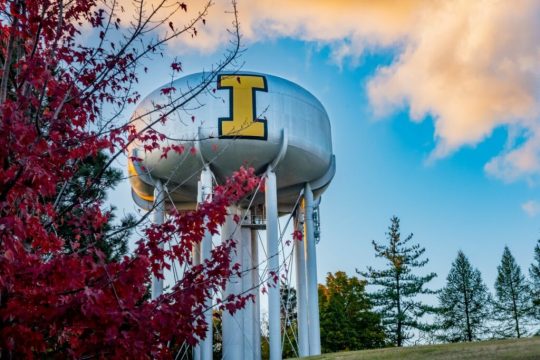
Curious about what it takes to be an Athletic Trainer? This blog post offers a unique perspective through the inspiring story of a recent University of Idaho's Master of Science in Athletic Training (MSAT) graduate. Dive into their firsthand experience and gain valuable insights into this exciting career path.
Get real-world insights from a Vandal alum:
Walk in the shoes of a successful Athletic Trainer: Discover their current role and how the MSAT program equipped them with the skills and knowledge to thrive.
Unearth their passion for the field: What sparked their interest in Athletic Training, and what made the University of Idaho's program stand out?
Go beyond academics: Uncover the program's supportive faculty, diverse learning opportunities, and impressive job placement record.
More than just a degree, it's a calling:
This testimonial is just a glimpse into the rewarding world of Athletic Training. Explore the MSAT program at the University of Idaho and unlock your potential to make a difference in athletes' lives.
Want to join the conversation? Share your thoughts on Athletic Training or ask questions about the program in the comments!
0 notes
Text
Ever wondered what it's like to be an athletic trainer at the University of Idaho?
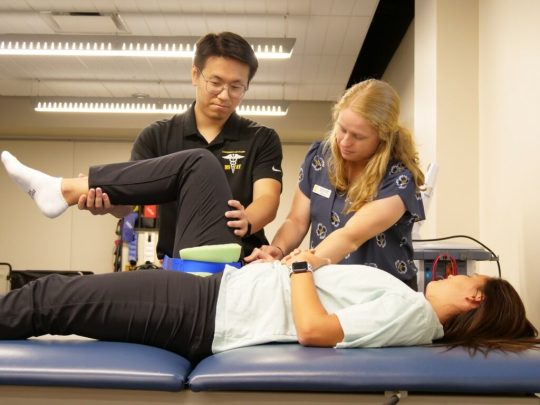
This blog post takes you on a journey through the daily life of a Vandal athletic trainer, offering a glimpse into their diverse tasks, work environments, and schedules. Whether you're an aspiring sports medicine professional or simply curious about this dynamic field at the University of Idaho, this article is packed with valuable insights.
Uncover the multifaceted world of University of Idaho athletic trainers:
From injury prevention and rehabilitation to performance enhancement and mental conditioning, these trainers wear many hats, ensuring Vandal athletes stay in peak condition. Witness their dedication as they work closely with athletes across various sports, helping them overcome injuries, recover from setbacks, and achieve their full potential.
Explore their varied work settings, from the state-of-the-art Kibble Dome to the bustling practice facilities and competition venues. See how they adapt their expertise to different environments, ensuring athletes receive the best possible care wherever they are.
Understand the dynamic schedule of a University of Idaho athletic trainer. Expect a fast-paced environment! While many trainers work standard hours, evenings, weekends, and travel are often part of the equation, especially during competition seasons. Witness their dedication and commitment as they support athletes throughout their training and competition journeys.
But that's not all! This article also sheds light on the personal qualities and skills that make a successful athletic trainer. You'll gain valuable knowledge about the dedication, resilience, and teamwork essential for thriving in this rewarding career.
So, are you ready to join the dynamic world of University of Idaho athletic trainers? This blog post is just the first step on your journey. By understanding their daily tasks, work settings, and schedules, you can gain valuable insights into whether this fulfilling career path at the University of Idaho is right for you.
0 notes
Text
A Day in the Life of an NFL Trainer

NFL athletic trainers play a vital role in safeguarding the well-being and performance of players. Their expertise spans injury prevention, diagnosis, and rehabilitation, contributing to the overall health of the team. The demanding nature of their job involves early starts, long working hours, and being on call 24/7 during the intense football season. Despite the challenges, many find satisfaction in the unique and glamorous world of professional football, appreciating the camaraderie shared with team members.
In terms of compensation, the average salary for NFL athletic trainers in 2008 was $64,266, with variations based on experience ranging from $30,000 to over $100,000 annually.
To pursue a career as an NFL athletic trainer, individuals must complete a master's program, pass the Board of Certification (BOC) exam, and commit to ongoing education. State licensure and collaboration with physicians are also crucial components. Programs like the MSAT at the University of Idaho provide an immersive clinical model, ensuring students gain over 900 hours of hands-on experience, and fostering valuable connections for their future roles in settings like the NFL.
0 notes
Text
Distinctive Careers for Athletic Training Professionals
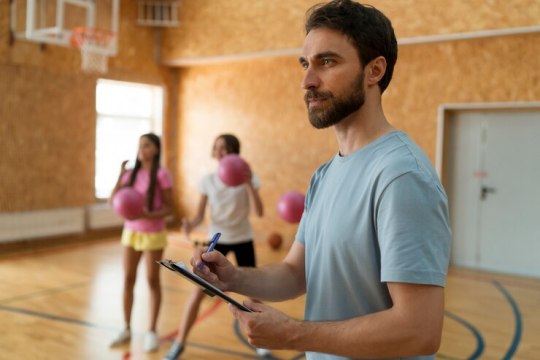
Athletic trainers are not limited to working in traditional sports settings. They can also find fulfilling careers in alternative jobs, such as industrial, military, occupational health, public safety, and emergency services. If you are interested in becoming an athletic trainer, you may think that your only career option is to work with sports teams or athletes. However, this is not the case. Athletic trainers have a wide range of skills and knowledge that make them valuable in many other settings and roles. In this blog post, you will learn about some of the unique and alternative jobs for athletic trainers that are available in different industries and sectors. You will also find out how the University of Idaho's Master of Science in Athletic Training (MSAT) Program prepares students for these diverse and exciting career paths.
0 notes
Text
Tips and Tricks to Finance Your Graduate Studies in Athletic Training
This blog post helps you explore the various ways to finance your graduate education in athletic training, a rewarding career with ample job opportunities. It features an interview with Dr. Ann Brown, a performance nutrition specialist and director of the Human Performance Laboratory at the University of Idaho. The blog post covers topics such as scholarships and grants, off-campus employment, student loans and financial aid, and graduate assistantships. It also provides some practical tips and recommendations for athletic training students to reduce their financial stress and focus on their academic and professional development.
0 notes
Text
The Athlete's Plate: Mastering Nutrition for Optimal Performance and Recovery
This blog post explores the importance of sports nutrition for athletes, as well as busts some common myths. It features an interview with Dr. Ann Brown, a performance nutrition specialist and director of the Human Performance Laboratory at the University of Idaho. The blog post covers topics such as optimal energy levels, enhanced recovery, improved endurance and stamina, strength and muscle growth, maintaining a healthy weight, and protein intake. It also provides some practical tips and recommendations for athletes to improve their nutrition and performance.
1 note
·
View note
Text
Doctor of Athletic Training: Shaping the Future of Sports Healthcare
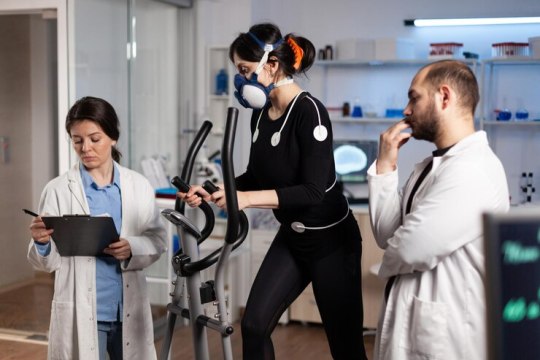
Our Doctor of Athletic Training program at the University of Idaho is at the forefront of revolutionizing sports healthcare. With a commitment to innovation, excellence, and leadership in the field of athletic training, this program is designed to empower professionals to shape the future of sports medicine and athlete well-being.
As a student in our Doctor of Athletic Training program, you'll delve deep into advanced coursework and gain hands-on experience, equipping you with the skills, knowledge, and expertise needed to excel in the dynamic world of sports healthcare. You'll collaborate with esteemed faculty and professionals who are dedicated to pushing the boundaries of what's possible in athletic training and sports medicine.
Join us at the University of Idaho and become a part of the next generation of leaders who will shape the landscape of sports medicine, helping athletes perform at their best and stay at the peak of their physical health.
#SportsHealthcare#AthleticTraining#FutureofSportsMedicine#InnovationInHealthcare#SportsPerformance#LeadersInAthleticTraining#DoctorateProgram#UofIdahoDAT
0 notes
Text
Master Your Athletic Training Journey at the University of Idaho

Embark on an extraordinary educational expedition as you choose to master your athletic training journey at the University of Idaho. Our comprehensive Master of Science in Athletic Training (MSAT) program is your passport to excellence in this dynamic field. Through a unique blend of advanced coursework, hands-on clinical experiences, and cutting-edge research opportunities, our program empowers you to reach new heights in athletic training.
As a pioneer in athletic training education, the University of Idaho has designed the MSAT program to inspire and prepare the next generation of athletic training professionals. We believe in equipping our students with the knowledge, skills, and expertise needed to excel in a competitive and evolving industry.
With a faculty comprised of renowned experts and a state-of-the-art learning environment, our program offers a transformative experience. The MSAT at the University of Idaho isn't just a degree, it's a key to unlock the full potential of your athletic training career. We are committed to fostering your growth, from foundational principles to advanced techniques.
Join us, and together, we'll navigate this extraordinary journey of mastery. Discover how the MSAT program at the University of Idaho can be your pathway to a fulfilling and impactful career in the world of athletic training.
1 note
·
View note